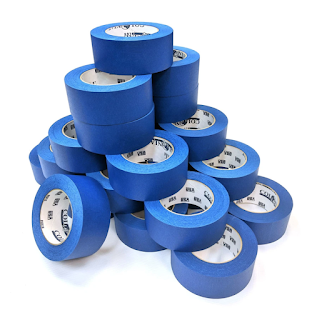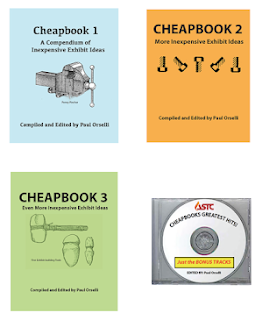Paul was also kind enough to respond to a few questions about his work and his new book for ExhibiTricks readers. Enjoy!
What got you interested in being a science presenter?
As a child, I was obsessed with two things — science and magic. Performing magic shows allowed me — for a limited time — to overcome my natural shyness and introversion. As an adult, I discovered that I could combine elements of both of these passions to perform science demo shows which provoked emotions in my audience. I'm still shy and introverted, but for the duration of a show, I'm able to exaggerate other parts of my personality to engage the audience ... on a good day :-) I love being able to trigger other people to experience some of the wonderful emotions I have when I encounter the scientific phenomena which surround us.
A pivotal moment in this journey was studying for an MSc in Communicating science at Techniquest science centre in Cardiff, Wales. This is when I stumbled upon what I wanted to do as a career — exploring ways of getting people curious about science by demonstrating how it affects so much of our lives. Latterly, this has morphed into a deeper quest searching for the psychological interest hooks that make some things universally interesting to almost everybody. I've become obsessed with trying to collect and categorise these hooks.
Tell us a little bit more about your Hook Your Audience book.
When I was studying for my MSc, I became frustrated at not being able to find books that explained how to engage audiences as a professional science presenter. It seemed you had to learn everything through peer wisdom and training in your organisation, from watching other presenters or by discovering it yourself through performing. All of these sources are important and necessary, but having to rely solely on them — rather than leveraging books to give you a head start — struck me as extremely inefficient and slow.
So in a short appendix to a module assignment on presentation skills, I started a life-long habit of reflecting on my performances and capturing the techniques I was using or observing in other presentations. Over 21 years (including a Ph.D. on how educators can create interest through their performance), a 20-page appendix grew into a 90k word book.
Hook Your Audience (Volume 1) is a toolkit of performance techniques to emotionally engage child and family audiences in interactive, educational presentations. It's aimed at career informal educators working in visitor attractions or outreach organisations. One of the central ideas behind the book is that, in informal education, nobody has to listen to you. So without being able to win and keep the attention of your audience, all of your other objectives are impossible to achieve. The question is — how do you do this? Spoiler alert - engage their emotions and interact with them.
There. That'll save you reading the whole book :-)
Sometimes people ask me about the "Volume 1" in the title. This book covers the first half of the delivery toolkit (character; liveness; expressing emotions; all-audience interaction; volunteers; questions; humour) and, somewhat predictably, volume 2 should address the other delivery tools (e.g. creating focus through your voice and body; suspense and surprise; telling stories; explaining; images, props and demos; and managing audience behaviour).
What are some of your favorite resources for people interested in finding out about how to give interactive science presentations?
I spend much of my life being a liminal — I lurk on the edges of many different fields and look for ideas that transfer well into the worlds of education and presenting. There's lots we can learn from other fields where attention is fiercely competitive, e.g. performing artists (such as magicians, stand-ups, actors, street performers, improvisers, children's entertainers); advertisers and copywriters; journalists; filmmakers and screenwriters; playwrights and theatre directors; computer game and app designers; fiction writers; viral video stars. All of these people live, or die, by how well they can sustain the attention of their voluntary audiences. Many of the principles and techniques in Hook Your Audience have been borrowed from other professional performing arts.
Three books from completely different genres that I would recommend to any science presenter to help them reflect on how they engage their audiences are:
●
Maximum Entertainment 2.0, by Ken Weber — one of my favourite books about performing skills for magicians. It gives a glimpse into the incredible deliberation and attention to detail professional performers invest in every part of their act.
●
Khrushchev's shoe: And Other Ways To Captivate An Audience Of One To One Thousand, by Roy Underhill — this undiscovered gem of a book contains a wealth of wisdom about keeping the attention of your audience. Its author has had an eclectic career in theatre, demonstrating at an outdoor museum and hosting one of the longest-running educational programmes on American television, but he is a master teacher at heart.
What do you think is the “next frontier” for science presenters?
If the last 18 months have taught us anything, it's the danger of making confident predictions about what will happen in this world so shaped by humans, for both good and ill. However, I'll try and answer this question by using three perspectives that I believe will each affect how the medium of the science demo show evolves - there are so many exciting possibilities that lie ahead.
a) Science Show Issues
Science presenters are already starting to address some of these issues, but we are still at the beginning of this process, e.g.
● widening the range of subjects explored in science shows beyond the physical sciences;
● investigating how shows can be used to discuss ethical questions and to motivate long-term attitude and behaviour change;
● exploiting the power of story to create more engaging and memorable shows;
● more clearly revealing how science works (a key factor in building the public's trust in science);
● incorporating robust findings from science communication, education, and psychological research into how we devise and deliver shows, where they exist;
● using the latest AV technology to bring scientific ideas to life on the stage (e.g. augmented reality) and to better interact with the audience (e.g. using audience polling, and even physiological measurement of their emotional states, to shape the direction of a live show);
● finding meaningful ways to evaluate the impact of one-off shows, but doing so in a way that doesn't damage the precious experience we trying to create.
b) Societal Trends
Science shows thankfully aren't written in a vacuum. They are informed by concerns and changes in society. These trends include — striving to make our shows more inclusive and diverse in order to connect with more people; considering how to better support presenters who are experiencing mental health difficulties because of the pressures of the constant need to emote on demand for their job; and developing engaging virtual show formats that are likely to remain an option in our future hybrid world.
c) The P Word
There is an elephant in the room affecting the science show sector — the fundamental need to professionalise everything we do as science presenters. We need to be much more intentional about every aspect of how we write, rehearse and deliver science shows. We need to create the frameworks that exist in other professions — a range of resources to support the development of presenters over their career; a structure that allows for career progression in the organisations in which presenters work; and, if not agreed standards, at least begin a discussion about what constitutes an effective science show for particular objectives.
If money were no object, what would your “dream” project be?
My dream project? Imagine if the Blue Man Group devised a spectacular science demo stage show. A performance that moved the audience to experience the full gamut of emotions invoked by awesome demonstrations of the power and the mysteries of science.
Now I'm not saying that every science show should have these goals and production values, but I'm convinced there's room for science demo shows in the harsh commercial arenas of the West End or Broadway. Part of the motivation for this dream is the romantic in me harking back to the early days of theatrical science demonstrations when "wonder shows" were all the rage. In the eighteenth and nineteenth centuries, the public queued up to witness dramatic stage demos revealing the latest scientific breakthroughs. One of the saddest aspects of modern life for me is that so many of us seem to have lost the capacity to feel wonder.
Thanks again to Dr. Paul McCrory for sharing his thoughts with ExhibiTricks readers -- make sure to check out
Hook Your Audience by clicking over to
Paul's website!
Don't miss out on any ExhibiTricks posts! It's easy to get updates via email or your favorite news reader. Just click the
link on the upper right side of the blog.
Paul Orselli writes the posts on ExhibiTricks. Paul likes to combine interesting people, ideas, and materials to make exhibits (and entire museums!) with his company
If you enjoy the blog, you can help keep it free to read and free from ads by supporting ExhibiTricks through our














































